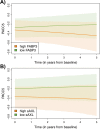Serum IL-6, sAXL, and YKL-40 as systemic correlates of reduced brain structure and function in Alzheimer's disease: results from the DELCODE study
- PMID: 36631909
- PMCID: PMC9835320
- DOI: 10.1186/s13195-022-01118-0
Serum IL-6, sAXL, and YKL-40 as systemic correlates of reduced brain structure and function in Alzheimer's disease: results from the DELCODE study
Abstract
Background: Neuroinflammation constitutes a pathological hallmark of Alzheimer's disease (AD). Still, it remains unresolved if peripheral inflammatory markers can be utilized for research purposes similar to blood-based beta-amyloid and neurodegeneration measures. We investigated experimental inflammation markers in serum and analyzed interrelations towards AD pathology features in a cohort with a focus on at-risk stages of AD.
Methods: Data of 74 healthy controls (HC), 99 subjective cognitive decline (SCD), 75 mild cognitive impairment (MCI), 23 AD relatives, and 38 AD subjects were obtained from the DELCODE cohort. A panel of 20 serum biomarkers was determined using immunoassays. Analyses were adjusted for age, sex, APOE status, and body mass index and included correlations between serum and CSF marker levels and AD biomarker levels. Group-wise comparisons were based on screening diagnosis and routine AD biomarker-based schematics. Structural imaging data were combined into composite scores representing Braak stage regions and related to serum biomarker levels. The Preclinical Alzheimer's Cognitive Composite (PACC5) score was used to test for associations between the biomarkers and cognitive performance.
Results: Each experimental marker displayed an individual profile of interrelations to AD biomarkers, imaging, or cognition features. Serum-soluble AXL (sAXL), IL-6, and YKL-40 showed the most striking associations. Soluble AXL was significantly elevated in AD subjects with pathological CSF beta-amyloid/tau profile and negatively related to structural imaging and cognitive function. Serum IL-6 was negatively correlated to structural measures of Braak regions, without associations to corresponding IL-6 CSF levels or other AD features. Serum YKL-40 correlated most consistently to CSF AD biomarker profiles and showed the strongest negative relations to structure, but none to cognitive outcomes.
Conclusions: Serum sAXL, IL-6, and YKL-40 relate to different AD features, including the degree of neuropathology and cognitive functioning. This may suggest that peripheral blood signatures correspond to specific stages of the disease. As serum markers did not reflect the corresponding CSF protein levels, our data highlight the need to interpret serum inflammatory markers depending on the respective protein's specific biology and cellular origin. These marker-specific differences will have to be considered to further define and interpret blood-based inflammatory profiles for AD research.
Keywords: Alzheimer’s disease; Biomarker; Blood-based; Cognition; Inflammation; Structural MRI.
© 2023. The Author(s).
Conflict of interest statement
MTH and FJ have associate editor positions at the
Figures




References
-
- Ashton NJ, Leuzy A, Karikari TK, Mattsson-Carlgren N, Dodich A, Boccardi M, et al. The validation status of blood biomarkers of amyloid and phospho-tau assessed with the 5-phase development framework for AD biomarkers. Eur J Nucl Med Mol Imaging. 2021. [cited 2021 Mar 30]. Available from: http://link.springer.com/10.1007/s00259-021-05253-y. - DOI - PMC - PubMed
-
- Brosseron F, Krauthausen M, Kummer M, Heneka MT. Body fluid cytokine levels in mild cognitive impairment and Alzheimer’s disease: a comparative overview. Mol Neurobiol. 2014; Available from: http://www.ncbi.nlm.nih.gov/pubmed/24567119. - PMC - PubMed
Publication types
MeSH terms
Substances
LinkOut - more resources
Full Text Sources
Medical
Research Materials
Miscellaneous

